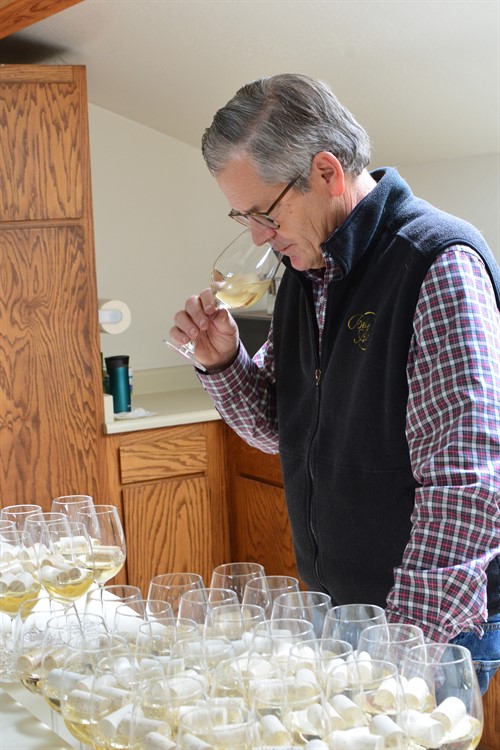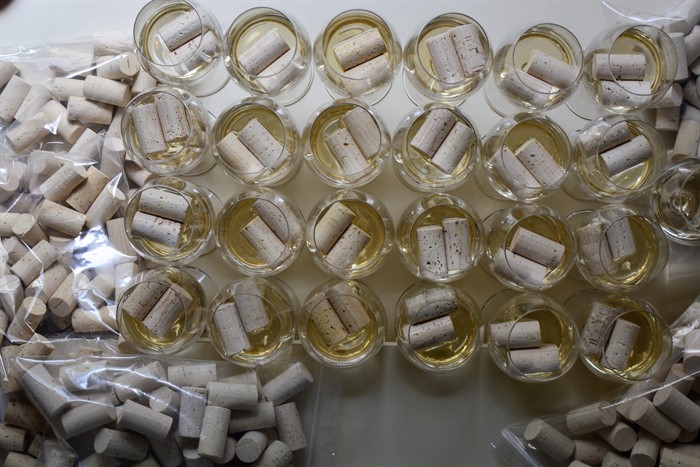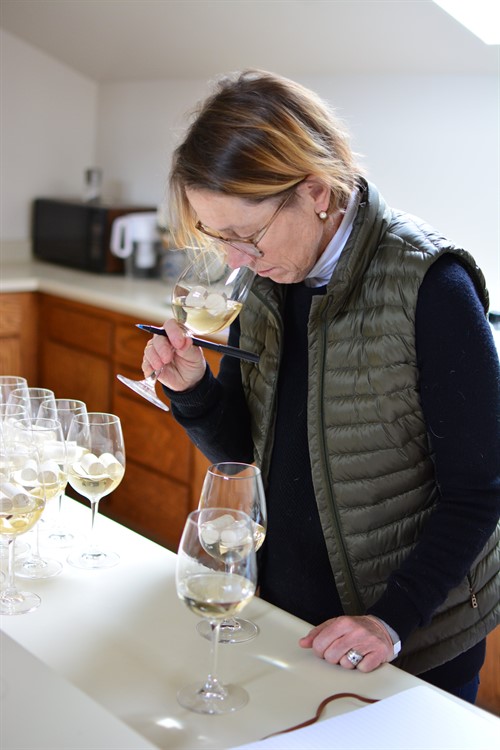Cork Trials
- February 19, 2019
As we prepare to bottle the 2017 Reserve Chardonnay and the 2018 Rosé this month, we conduct a difficult and critical tasting…our cork trials. Why is it critical, you ask? It’s really quite simple. After spending months, years crafting our wines, we don’t want a cork to ruin our wine.
We do believe that corks are a valuable part of our industry. They are truly a sustainable product–cork forests are carefully managed and the bark of cork trees is harvested every seven years. As a closure, they allow the wine to develop and age through the pores of the cork, whereas plastic corks or screw caps do not. And yet, corks can sometimes impart a mustiness/corkiness that comes from the compound trichloroanisole (TCA). Over the years, cork producers have worked diligently to reduce the risk of TCA by eliminating the use of chlorine in the processing of corks. In 1982, when we started making wine at Hafner Vineyard, the industry believed that approximately 5% of all corks were considered tainted. Today, it is less than 1%. Our tastings have borne this out–20 years ago, at least one sample would be corky. Today, rarely is there one, but we always conduct cork trials to ensure that we are buying the best corks possible. What do we do here at Hafner Vineyard to ensure that the corks we buy will not affect our wines? First, we request samples from three, sometimes four cork manufacturers and each cork company sends two to four samples (50+ corks per sample.) We visually check them: looking for flaws (cracks, bark, number and size of pores) and rank them accordingly. Then the fun begins! To see how the corks actually affect the wine, we purchase a generic, non-descript white wine, one that isn’t overly aromatic that would mask the cork aromas. We pour 80 mls wine in each glass along with two corks; we replicate this four times per cork sample. (At this tasting, we had 13 cork samples for a total of 52 glasses of wine.) We then cover the glasses with plastic wrap and leave them overnight.
What do we do here at Hafner Vineyard to ensure that the corks we buy will not affect our wines? First, we request samples from three, sometimes four cork manufacturers and each cork company sends two to four samples (50+ corks per sample.) We visually check them: looking for flaws (cracks, bark, number and size of pores) and rank them accordingly. Then the fun begins! To see how the corks actually affect the wine, we purchase a generic, non-descript white wine, one that isn’t overly aromatic that would mask the cork aromas. We pour 80 mls wine in each glass along with two corks; we replicate this four times per cork sample. (At this tasting, we had 13 cork samples for a total of 52 glasses of wine.) We then cover the glasses with plastic wrap and leave them overnight. The next day, we smell each glass and rank each sample group. We always have a control sample (a glass of the wine that does not have any corks in it), so that we know what the wine smells like without the cork. Throughout the tasting, we refer back to the control glass, in essence to calibrate our noses. Smelling 52 glasses of cork-infused wine is tiring, to say the least. I do not do this alone; everyone on the production team (Ricardo, Sarah and I) gets to join in on the fun. As we smell each sample, we note how the cork has changed the aroma of the wine. Typically, our descriptors range from neutral, floral (which is good) to papery, dusty (which is bad.) If a sample is musty (and is tainted with TCA), then that group of corks is rejected, no questions asked. The goal is to find the most neutral samples, the ones that are most like the glass of control wine.
The next day, we smell each glass and rank each sample group. We always have a control sample (a glass of the wine that does not have any corks in it), so that we know what the wine smells like without the cork. Throughout the tasting, we refer back to the control glass, in essence to calibrate our noses. Smelling 52 glasses of cork-infused wine is tiring, to say the least. I do not do this alone; everyone on the production team (Ricardo, Sarah and I) gets to join in on the fun. As we smell each sample, we note how the cork has changed the aroma of the wine. Typically, our descriptors range from neutral, floral (which is good) to papery, dusty (which is bad.) If a sample is musty (and is tainted with TCA), then that group of corks is rejected, no questions asked. The goal is to find the most neutral samples, the ones that are most like the glass of control wine. After the three of us have ranked the wines, we tally the scores and discuss our results. If by chance, we don’t agree; we do the cork trial again until we reach a consensus. We always split our order between two different sample groups, sometimes we buy from two different suppliers, sometimes just from one company, but always two different lots of corks. It’s a simple insurance policy, like not putting all of your eggs in one basket. Once we have selected, ordered and received the corks, we do smell each bag before it is used…as one last final check before putting it in the bottle.
After the three of us have ranked the wines, we tally the scores and discuss our results. If by chance, we don’t agree; we do the cork trial again until we reach a consensus. We always split our order between two different sample groups, sometimes we buy from two different suppliers, sometimes just from one company, but always two different lots of corks. It’s a simple insurance policy, like not putting all of your eggs in one basket. Once we have selected, ordered and received the corks, we do smell each bag before it is used…as one last final check before putting it in the bottle.
Our cork trials are just one of the ways we work to ensure that every bottle of Hafner wine is the best it can possibly be.



